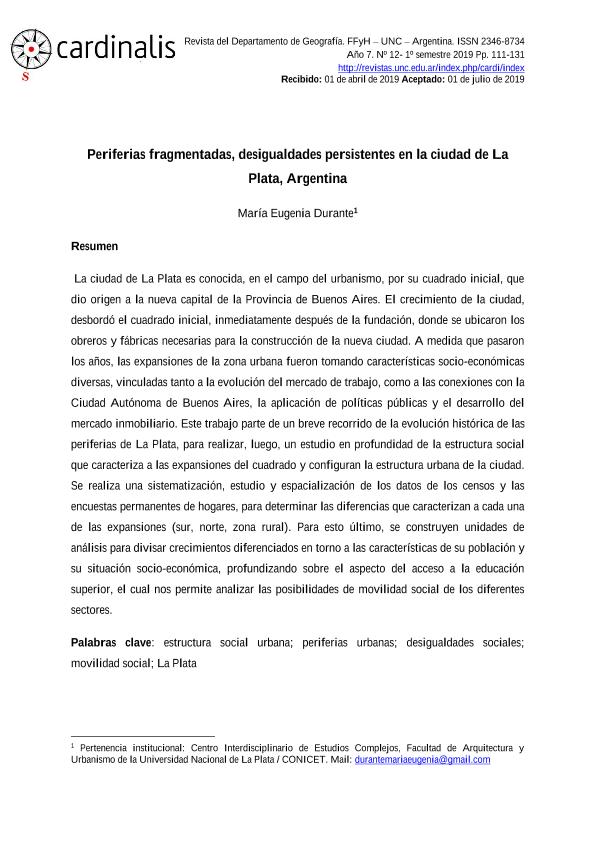Artículo
La ciudad de La Plata es conocida, en el campo del urbanismo, por su cuadrado inicial, que dio origen a la nueva capital de la Provincia de Buenos Aires. El crecimiento de la ciudad, desbordó el cuadrado inicial, inmediatamente después de la fundación, donde se ubicaron los obreros y fábricas necesarias para la construcción de la nueva ciudad. A medida que pasaron los años, las expansiones de la zona urbana fueron tomando características socio-económicas diversas, vinculadas tanto a la evolución del mercado de trabajo, como a las conexiones con la Ciudad Autónoma de Buenos Aires, la aplicación de políticas públicas y el desarrollo del mercado inmobiliario. Este trabajo parte de un breve recorrido de la evolución histórica de las periferias de La Plata, para realizar, luego, un estudio en profundidad de la estructura social que caracteriza a las expansiones del cuadrado y configuran la estructura urbana de la ciudad. Se realiza una sistematización, estudio y espacialización de los datos de los censos y las encuestas permanentes de hogares, para determinar las diferencias que caracterizan a cada una de las expansiones (sur, norte, zona rural). Para esto último, se construyen unidades de análisis para divisar crecimientos diferenciados en torno a las características de su población y su situación socio-económica, profundizando sobre el aspecto del acceso a la educación superior, el cual nos permite analizar las posibilidades de movilidad social de los diferentes sectores. The city of La Plata is known, in the field of urban planning, for its initial square, which gave rise to the new capital of the Province of Buenos Aires. The growth of the city, overflowed the initial square, immediately after the foundation, where the workers and factories necessary for the construction of the new city would be located. As the years went by, the expansions of the urban area will take diverse socio-economic characteristics, linked both to the evolution of the productive circuits and the labor market, as well as to the connections with the Ciudad Autónoma de Buenos Aires the application of public policies and the development of the real estate market. This work starts from a brief tour of the historical evolution of the peripheries of La Plata, to then carry out an in-depth study of the social structure that characterizes the expansions of the square and configure the urban structure of the city. A systematization, study and spatialization of census data and permanent household surveys are carried out to determine the differences that characterize each of the expansions (south, north, rural area). For this, analysis units are built to see differentiated growths around the characteristics of their population and their socio-economic situation, deepening on the aspect of access to higher education, which allows us to analyze the possibilities of social mobility of the different sectors.
Periferias fragmentadas, desigualdades persistentes en la ciudad de La Plata, Argentina
Título:
Fragmented peripherals, persistent inequalities in the city of La Plata,
Argentina
Fecha de publicación:
15/07/2019
Editorial:
Universidad Nacional de Córdoba. Facultad de Filosofía y Humanidades. Departamento de Geografía
Revista:
Cardinalis
ISSN:
2346-8734
Idioma:
Español
Tipo de recurso:
Artículo publicado
Clasificación temática:
Resumen
Archivos asociados
Licencia
Identificadores
Colecciones
Articulos(CCT - LA PLATA)
Articulos de CTRO.CIENTIFICO TECNOL.CONICET - LA PLATA
Articulos de CTRO.CIENTIFICO TECNOL.CONICET - LA PLATA
Citación
Durante, Maria Eugenia; Periferias fragmentadas, desigualdades persistentes en la ciudad de La Plata, Argentina; Universidad Nacional de Córdoba. Facultad de Filosofía y Humanidades. Departamento de Geografía; Cardinalis; 12; 15-7-2019; 111-131
Compartir




